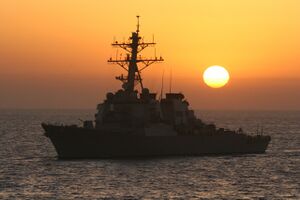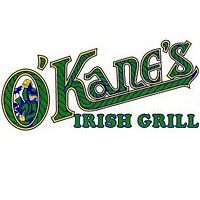USS O'Kane (DDG-77)
USS O'Kane (DDG-77) is a United States Navy destroyer of the "flight 2" variant of the Burke-class. She was built at the Bath Iron Works and was the second ship commissioned, on 28 March 1998, in her home port, Pearl Harbor, Hawaii (U.S. state). In operation, she is assigned to Destroyer Squadron 31 of the U.S. Pacific Command.[1]
Assignment
She is part of the Pacific Fleet's Mid-Pacific Surface Combatant Operational Employment, a program that increases tempo of operations by fully basing ships at Pearl Harbor, rather than sending them back to San Diego.
In February 2009, she participated in ANNUALEX 20G, a regular exercise with the Japanese Maritime Self-Defense Force, and the defense of Iraqi oil platforms in the Persian Gulf.
In 2007, the O'Kane was part of the Carrier Strike Group built around the USS Stennis (CVN-74), operating with the United States Fifth Fleet in the Middle East. Fifth Fleet is the naval component of United States Central Command. The Stennis CSG will operate with that of the USS Eisenhower (CVN-69), in Eisenhower Carrier Strike Group, already in the Central Command area of operations. The strike groups will support Operation Enduring Freedom, Operation Iraqi Freedom and Combined Joint Task Force Horn of Africa and will conduct maritime security operations. [2]
Ship's organization
Her captain is CDR Timothy Steadman. CDR Derek A. Trinque is the executive officer, and John A. Hall is Command Master Chief.
Combat Systems Department
This department centers around the computers and sensors of the AEGIS battle management system, coordinating the effects of the ship as a whole, although the Weapons Department actually maintains the weapons it controls.
Weapons Department
The Weapons Department officer is responsible for three divisions of specialists, and two missions that are staffed from the department:
- CS Division is primarily made up of sonar technicians (ST) who run the AN/SQQ-89 Integrated anti-submarine warfare (ASW) Suite, using a AN/SQR-19 Tactical Towed Array sonar for long-range passive detection of enemy submarines and a AN/SQS-53C Hull-Mounted sonar is used actively and passively to detect and localize submarine contacts.
- Flight II Burkes can launch and recover helicopters, but, as opposed to Flight IIA, do not have hangars and full support facilities. Nevertheless, the ship has RAST cabling for helicopter handling and can temporarily support them to localize and attack submarines and conduct Over-The-Horizon Targeting missions.
- The ship can attack hostile submarine contacts by firing torpedoes from her six MK 32 Surface Vessel Torpedo Tubes or, for contacts at greater ranges, Vertical Launch Anti-Submarine Rockets (VLA) fired from the MK 41 Vertical Launching System.
- CG Division is primarily made up of Gunners Mates, responsible for the safekeeping and transportation of almost all gun ammunition on board the ship, and most of the weaponry used to fire the ammunition. These include the MK 45 [[5"-54 caliber Gun Mount, in conjunction with the MK 34 Gun Weapon System, for anti-surface warfare, anti-air warfare], and naval gunfire support. The division also maintains the ship's 25mm, M2HB, and M240 machine guns.
- Fire Control Technicians are the main rating in CM division, handling the long-range missiles. They operate the vertical launch system for BGM-109 Tomahawk, RUM-139 VL-ASROC and RIM-156 Standard SM-2 missiles.
FORCE PROTECTION AND ANTI-TERRORISM. Select personnel on the ship are trained to implement force protection measures. Whether in homeport or overseas, Force Protection is vital in ensuring the safety and security of the ship so that the crew can perform its mission.
VISIT, BOARD, SEARCH AND SEIZURE. VBSS teams are utilized for direct interaction with theatre-wide mariners. This is to ensure that freedom of navigation is tenable, international and national sanctions are enforced, and our international relations with the world’s mariners are in accordance with na
Operations Department
In many respects the core department, Operations runs the ship as a ship. While Weapons may load the launchers and Combat Systems aims them, operations navigates the ship to the place they will be used.
Operations Department principle role is to support the ship in sustained operations at sea as a part of a Joint Task Group or as an independent unit in Anti-Air, Anti-Surface, Anti-Submarine and Strike Warfare operations against the enemy. Secondary roles include fixed and rotary-wing aircraft control, electronic and celestial navigation, electronic and visual communication, Naval Gunfire Support, Electronic Warfare, Search and Rescue.
- OD Division is comprised of Boatswain's Mates (BMs), Boatswain's Mates (BM) are one of the oldest traditional ratings in any navy; a boatswain from a Greek trireme would at least recognize some functions of a modern ship. BMs are the experts in deck seamanship, and the mundane but necessary tasks of maintenance. Rust is the enemy of all ships; someone from this division will usually be painting something. The division officer has the traditional title of First Lieutenant.
- OI01 Division runs the Combat Information Center; its primary enlisted personnel are Operations Specialists (OSs). They evaluate radar displays, identify contacts, and carry out the tactical decisions for the Combat System Officer. They plot imagery data using maps and charts and receive data from computerized intelligence systems ashore and afloat; shipboard signals intelligence collection is in . This division is responsible for the collection and dissemination of all combat information required for the ship to assess the tactical situation, and successfully employ the unique combat capabilities of the complex warship. The Combat Information Center Officer leads OI Division in the performance of its duties.
- OI02 Division, headed by the ship's Navigator, consists of Quartermasters (QMs), who steer the ship, and, in an electronics-intensive ship, are the experts in looking out the window. When the ship is underway, a Quartermaster is always on watch on the bridge to determine the ships position, assist the Officer of the Deck, and track the Path of Intended Movement (PIM). QMs are experts in visual communications, allowing the ship to communicate with other ships in sight, without using electronic means, which can be detected by the enemy.
- OT Division is made up of communications technicians, who , decrypt, intercept and jam all ranges of signals and information both friendly and foe.
Supply Department
If the crew replaces broken parts with it, eats it, or spends it, the Supply Department is involved.
S-1 division runs inventory, storage, and dispensing of parts. Two divisions, S-2 and S-5, provide food services, S-2 to the crew and S-5, with the same meals but different accounting to the officers.
S-3, or Sales and Services Division, runs the Barber Shop, Laundry, Ship's Store and Vending Machines. "If it needs to be bought, cut, or washed, the SHs are the professionals that get the job done." S-4 Division is the finance department, from pay to travel to safe deposit. The ship has an Automated Teller Machine (ATM).
Administration Department
This department both handles administrative services for the command, and includes the ship's personnel, medical, and master-at-arms functions.
Engineering Department
Under the ship's Chief Engineer, four divisions run the engines, auxiliary mechanical and electrical equipment, and provide damage control. While Supply Division cooks the food, Engineering Division makes the fresh water. Fresh water distillation, steering control, damage control, drainage, and sewage treatment. The Engineering Department is led by the Engineering Officer, known as "CHENG," who supervises all engineering evolutions and ensures his department maintains all equipment properly and is capable of responding and recovering from any casualty that may occur in the engineering plant.
- Auxiliaries Division maintains almost all of the ship's auxiliary engineering equipment on board the ship. Known as A-Gang, the Enginemen (ENs) are responsible for the ship's air conditioning plants, fresh water distillers, potable water system, sewage system, steering system, laundry service equipment and galley equipment. The ENs maintain gear from the bow of the ship to the stern, and are constantly working to fix problems.
- Electrical Division is primarily tasked with maintaining the ship's electrical distribution systems. Additionally, the Electrician Mates (EMs) are responsible for shipboard lighting, cathodic protection, casualty power, degaussing systems, and electrical tool issue and maintenance. Finally, the EMs, along with the ETs in CE Division, ensure that all personal electronic devices are safety- checked while approved for use on board the ship.
- In MP Division, the Gas Turbine Systems Mechanical Technicians (GSMs) and Gas Turbine Systems Electrical Technicians (GSEs) are primarily responsible for main propulsion and electrical power generation. The GSMs maintain four LM-2500 Gas Turbine Engines, and all associated equipment, in two Main Engine Rooms, necessary to provide and control propulsion. The GSEs are tasked with the upkeep of three Allison 501-K34 Gas Turbine Generators, capable of providing 2,500 Kilowatts each. Additionally, Main Propulsion Division is accountable for the storage and quality of the lubricating oil used throughout the engineering plant, and the fuel oil burned by the engines and helicopters.
- Damage Control Division is primarily responsible for training the ship's crew in proper fire-fighting, flooding, and other casualty response techniques: under U.S. Navy doctrine, every person aboard is a firefighter; a firefighting exercise is now the culmination of recruit training. Damage Controlmen (DCs) fix the equipment that fix things, and are the team leaders for all shipboard emergency response teams.
Technical characteristics
- Builder: Bath Iron Works
- Propulsion: Four General Electric LM 2500-30 gas turbines; two shafts, 100,000 total shaft horsepower.
- Length: 505 feet (153.92 meters)
- Beam: 59 feet (18 meters).
- Displacement: 8,637 L tons (8,775 metric tons) full load
- Speed: In excess of 30 knots.
- Crew: 26 officers, 330 enlisted
Offensive weapons
The Flight II is an incremental modification from Flight I; the most significant change came with Flight IIA, in which the AGM-84 Harpoon missile launchers were replaced by permanent helicopter hangars.
- RIM-156 Standard SM-2 long-range surface-to-air missile (SAM); Flight II added the SM-2 Block IV Extended Range
- RIM-162 ESSM medium-range SAM
- RUM-139 Vertical Launch ASROC
- RIM-161 Standard SM-3 when equipped with area BMD electronics
Defensive and countermeasures systems
- Super Rapid Blooming 6-barrelled SRBOC chaff and infrared decoy launchers;
- AN/SLQ-25A Nixie torpedo decoy system
- AN/SLQ-32(V)3 electronic warfare
- Phalanx close-in weapons system, to be replaced by RIM-116 Rolling Airframe Missile
- Mk 38 Bushmaster 25mm chain autocannon for use against boats and light targets
- AN/SQQ-89 ASW Combat System controls the RUM-139 Vertical Launch ASROC and the final-defense Mark 46 deck-launched torpedoes
- AN/SPS-64 surface search and navigation radar; not primarily a combat system
References
- ↑ USS O'KANE (DDG-77), FPO AP 96674-1295, "A Tradition of Honor", United States Navy
- ↑ "USS O’Kane departs for Fifth Fleet", Navy News Hawaii, February 2, 2007

